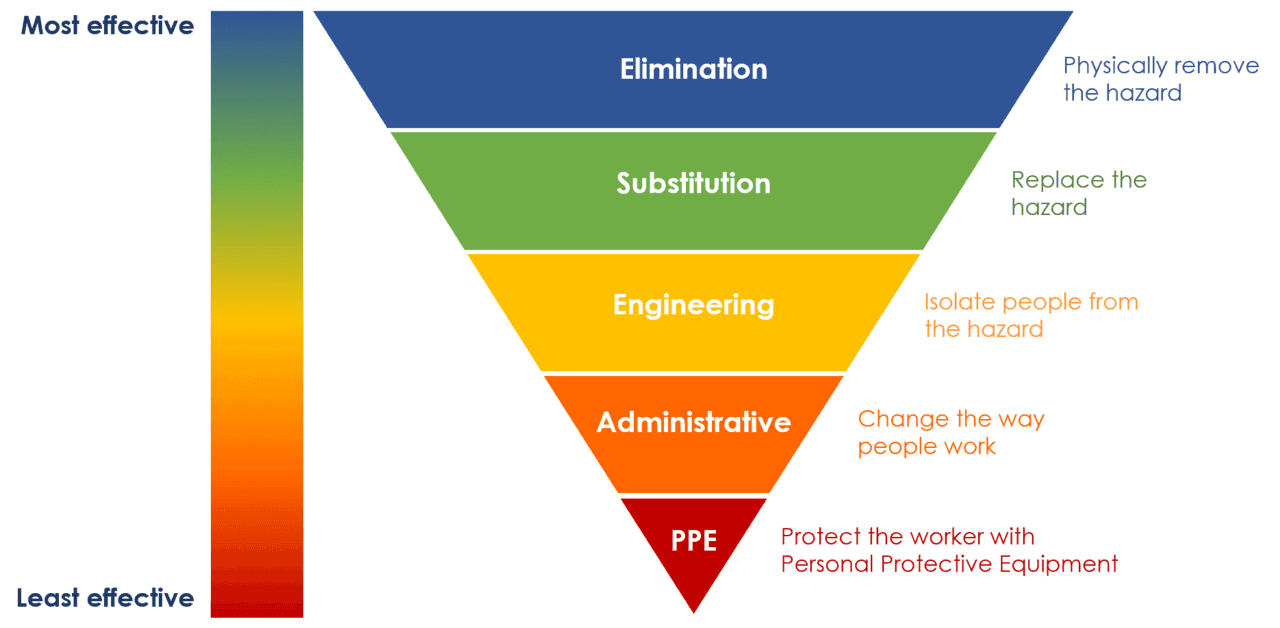The Hierarchy of Controls

Respiratory Protective Equipment (RPE) is just one means of protecting people from potentially hazardous materials, gases, pathogens and vapors in the air.
In fact, RPE is often referred to as the ‘last line of defense’ against respiratory hazards.
Thinking of RPE in these terms is helpful in two ways:
- If it fails – due to not being adequate for the hazard, or suitable for the wearer, for example – then there is no barrier between the wearer and the hazardous substance entering their lungs; and
- It is the last means of risk protection in the hierarchy of controls.
The hierarchy
The traditional hierarchy of controls for hazards shows us that when faced with hazards in the workplace, there is a proper order of response to best minimise risk and keep employees safe.
- Elimination
Can the task be removed completely? - Substitution
Can an alternative substance be handled that is less hazardous? - Engineering Controls
Can the hazard be isolated – e.g. through adequate air ventilation? - Administrative Controls
Can the risk be reduced through implementing regulations, such as timed working in hazardous areas? - Personal and Respiratory Protective Equipment (PPE and RPE)
Can the worker be protected sufficiently against harm through specially designed workwear?
A practical example
Fred works as a nurse at a local hospital and is asked to perform an Aerosol Generating Procedure (AGP) on Imelda who is being assessed for influenza. AGP’s carried out on potentially infectious patients require the use of an FFP3 respirator to prevent further spread of the illness.
Running through the hierarchy of controls we can see the reasons why Fred is required to wear RPE in this situation:
- Elimination
As it is not possible to remove the pathogen from the patient, this means of control is not possible - Substitution
If an AGP is required for further diagnosis, there are few alternative procedures that would offer the same results, so substitution too is not possible in this situation - Engineering Controls
Due to the close proximity of the member of staff performing an AGP and the patient, more powerful air ventilation systems or isolating the patient from the person giving the AGP would not be possible - Administrative Controls
Limiting the length of the procedure and/or the length of time the member of staff remains in the immediate vicinity of the patient may help reduce risk of cross contamination – however, it would not adequately protect the employee and could be distressing for the patient - RPE
FFP3 respirators, such as the FSM18 Easimask, protect the wearer from over 99% of hazardous particles in the air, including influenza.
Running through the hierarchy shows us that the only way Fred can be certain he is protected from catching influenza from Imelda, is by wearing an FFP3 respirator during the procedure.
Please note:
Most FFP3 respirators used in the healthcare environment are tight-fitting (whether single-use, half-face or full-face). Tight-fitting respirators of any kind require Fit Testing before first being used to ensure that the make/model of respirator suitably fits the wearer’s face. Not Fit Testing a respirator could lead the employee to have a false-confidence that they are protected from respiratory hazards, when in fact they are still breathing in contaminated air.
Fit Testing staff members required to use tight-fitting respirators before use is a legal requirement for the employer. Failure to do so could endanger staff health and lead to a considerable fine.

